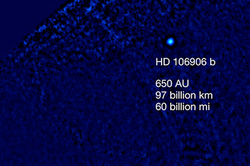 American astrologers made a startling discovery. They found the planet, which is placed unusually far from its own luminaries - 16 times farther away than Pluto from the Sun. Space object rotating around the star HD 106906 at a distance of several hundred light years from Earth. American astrologers made a startling discovery. They found the planet, which is placed unusually far from its own luminaries - 16 times farther away than Pluto from the Sun. Space object rotating around the star HD 106906 at a distance of several hundred light years from Earth.
Scientists from the California Institute in Berkeley (United States) has found yet another exoplanet. Distinguishes it from other distance in relation to the sun and space the object is from it 16 times farther away than Pluto from the Sun. Astrologers speculated, leading to a similar situation.
HD 106906 b, the planet revolves around a sun-like star HD 106906 a few hundred light years from Earth. The system in which they are located, has several distinctive features that allow scientists to build assumptions about what led to the distance of these objects from each other, informs Lenta.ru.
First, as noted scientists - an unusual angle of the plane of rotation of HD 106906 b around a star. Among other things, astrologers noted that the remnants of the protoplanetary disk of a space object are shifted in the direction of the light. Based on these data, the team has developed a hypothesis that the exoplanet was pushed out of your starting position. The results of the study were published in the Astrophysical Journal.
Wonderful space discoveries are happening quite often. Not so long ago Days.Roux reported that astrologers could observe an unusual phenomenon - a black hole swallowed a star, and then "spit out" residues in radiodifusora.
The conflict occurred approximately 300 million light-years from Earth, in the center of the galaxy PGC 043234. This outbreak, as demonstrated by further research, was visible in the soft x-ray spectrum, prompting its discoverers to believe that they are faced with the destruction of a star by a supermassive black hole at the center of PGC 043234.
sections: Society, World News
|